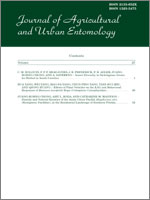Wax moth larvae (Lepidoptera: Pyralidae) are serious pests on wax combs outside and inside of beehives. Management of wax moths is particularly difficult inside hive bodies housing weak colonies. In this study, five traps were designed and evaluated for their efficacy to attract mature larvae inside beehives. These traps were: (1) mesh envelope trap (MET), (2) cup trap (CT), (3) corrugated sheet (CS), (4) wooden sheet trap (WST), and (5) frame trap (FT). The traps were designed to take advantage of the behavior of mature larvae seeking protected locations for pupation. The numbers of larvae fluctuated during the study with a major peak at the end of June. MET attracted the greatest numbers of larvae, followed by CS, CT and FT, whereas WST did not attract any larvae. The internal traps, particularly MET, may reduce the damage from wax moth larvae by reducing existing moth populations inside the beehives, and therefore, prevent additional infestation.
BioOne.org will be down briefly for maintenance on 17 December 2024 between 18:00-22:00 Pacific Time US. We apologize for any inconvenience.
How to translate text using browser tools
1 January 2017
Evaluation of Non-Chemical Traps for Management of Wax Moth Populations within Honey Bee Colonies1
Hossam F. Abou-Shaara
ACCESS THE FULL ARTICLE
It is not available for individual sale.
This article is only available to subscribers.
It is not available for individual sale.
It is not available for individual sale.
Apis mellifera
control
honey bees
traps
wax moths






